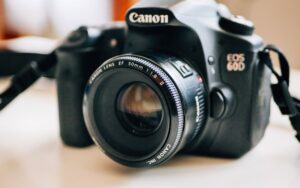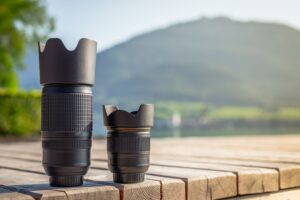Wondering how to store camera lenses properly? Proper storage is crucial for maintaining your lenses’ quality and longevity.
In this article, we’ll take a look at the importance of correct lens storage, practical tips, common threats, and much more.
Read on to ensure your lenses serve you well for years to come!
| Aspect | Best Practice |
|---|---|
| Positioning | Store with lens facing down and aperture narrowed. This minimizes dust settling and reduces impact risks. |
| Lens Caps | Always use them. They protect the lens from scratches, dirt, and other hazards. |
| Temperature Control | Avoid extreme temperatures. Both hot and cold can damage lens coatings and internal mechanics. |
| Moisture Control | Ensure storage is dry and well-ventilated. Avoid prolonged exposure to moisture to prevent fungus growth. |
| Physical Protection | Use dedicated lens pouches or hard cases. They offer cushioning and protection from physical impacts. |
| Desiccants | Use silica gel packets or other desiccants in storage areas to absorb excess moisture. |
| Regular Cleaning | Clean lenses before storing to remove fingerprints, dust, and other residues. This maintains lens clarity and quality. |
| Avoid Magnetic Sources | Store lenses away from strong magnetic fields which can affect the lens’ electronics. |
| Battery and SD Card Removal | If storing cameras along with lenses, remove batteries and SD cards to prevent potential damage. |
| Storage Location | Choose a location that’s away from direct sunlight, is cool, and has minimal humidity. |
How to Store Camera Lenses Properly: Quick Tips
Photography equipment is an investment, and just like any other investment, it requires care and maintenance.
Here are some simple guidelines to ensure your lenses remain in tip-top condition:
1. Position the Lens Facing Down and Aperture Narrowed
Storing your lens with the glass facing down and the aperture narrowed minimizes the risk of dust settling on the lens elements. This position also ensures fewer direct impacts on the glass should there be any accidental knocks.
2. Use a Lens Cap
Lens caps aren’t just fancy accessories—they’re your lens’s first line of defense. Always ensure you cap your lenses when not in use. This simple act can protect them from scratches, dirt, and other potential hazards.
3. Avoid Extreme Temperatures and Moisture
- Temperature: Avoid leaving your lenses in extreme temperatures, be it scorching heat or freezing cold. Such conditions can damage the lens coatings and even the internal mechanics.
- Moisture: Even if some lenses claim to be waterproof (and you can read more about that here), prolonged exposure to moisture can lead to fungus growth—a photographer’s worst nightmare. Always ensure your storage area is dry and well-ventilated.
By adhering to these simple yet essential tips, you’re already on the path to prolonging the life of your camera lenses. But, there’s much more to explore, so keep reading for a deeper dive into the world of lens care and storage.
The Biggest Threats to Your Camera Lenses
Every hero has its rivals, and in the world of photography, your lenses have their own set of foes. Let’s shine a light on these sneaky culprits:
Humidity and Water
Water, in all its forms, is a lens’s arch-nemesis. Whether it’s condensation on a cold morning or an accidental splash, water can wreak havoc on your camera lens. Internally, moisture can lead to fungus growth, while on the outside, it can erode coatings. And if you’re thinking, “are camera lenses waterproof?” – not all of them are, so it’s best to be cautious!
Dust, Sand, and Dirt
Ever spotted a speck in your perfect shot? That’s usually dust. These tiny particles, especially when combined with sand or dirt, can scratch your lens or even infiltrate the lens’s interior. Over time, this can reduce the clarity and quality of your images.
Oils and Chemicals
From fingerprints to harsh cleaning agents, oils and chemicals can affect your lens. They can smear the lens surface or, worse, degrade the special coatings that reduce reflections and improve image quality.
Extreme Weather
Lenses, like us, prefer moderate climates. Extreme cold can make lens mechanisms sluggish, while extreme heat can damage internal components. Always be wary of sudden temperature changes, as they can cause condensation inside the lens.
Top Solutions for Lens Storage
Now that we’ve identified the enemies, let’s armor up with the best storage solutions:
Dry Cabinets
Ever heard of a fortress for your lenses? That’s what a dry cabinet is. These specialized storage solutions maintain a constant, low-humidity environment, protecting your lenses from moisture and fungus. Wondering if dry cabinets are really worth it? The answer is a resounding yes for serious photographers.
Camera Bags and Dedicated Lens Pouches
When on the move, your lenses need snug homes. Quality camera bags and lens pouches offer padded protection, ensuring your lenses remain safe from bumps and drops.
Pelican Cases and Hard Cases
For those venturing into harsh terrains or simply wanting the best protection, Pelican cases or other hard cases are the way to go. They’re watertight, crushproof, and dustproof. Your lenses couldn’t ask for a better shield!
Desiccants
Desiccants are little packets with a mighty role! Desiccants absorb moisture, ensuring your storage environment remains dry. They’re especially useful in humid climates or during rainy seasons.
Industrial Shelving and Tool Chests
For the home studio or the dedicated photographer, industrial shelving or tool chests can be repurposed for lens storage. With compartments and drawers, you can keep your lenses organized, accessible, and safe.
Protection and Maintenance Tips
Beyond the basics of storage, the longevity of your lenses hinges on how you protect and maintain them. Here’s a quick rundown of how you can maintain your lenses and protect them from harm.
Screen Protectors, Lens Filters, and Their Necessity
Gone are the days when lenses were just about optics. With advancements, there’s an ecosystem of accessories to improve lens performance. But do you need them all?
Lens Filters: These are like sunglasses for your lenses, protecting against UV rays, glares, and potential scratches. But are lens filters truly necessary? They can be, especially if you’re frequently shooting outdoors or in challenging conditions.
Screen Protectors: For those with digital screens on their lenses or camera bodies, screen protectors act as a barrier against scratches and smudges. It’s a small investment for a clearer view.
Cleaning Your Lenses for Optimal Longevity
A crystal-clear shot requires a crystal-clear lens. Over time, fingerprints, dust, and smears can compromise your lens clarity. But, how do you clean your lens properly?
- Use the Right Tools: Soft-bristled brushes, microfiber cloths, and specialized cleaning solutions can make a world of difference.
- Gentle Circles: When cleaning, move in gentle, circular motions. Avoid pressing too hard.
- Safety First: Always ensure your lens is capped when not in use to minimize the need for cleaning.
Wondering about the nitty-gritty of cleaning? Dive deep into how to clean a camera lens here.
Removing Batteries and SD Cards for Storage Safety
When storing your camera body alongside lenses, remember to remove the batteries and SD cards. Batteries can leak over time, and you wouldn’t want any corrosion near your precious lenses.
Common Misconceptions About Lens Storage
In the world of photography, there are plenty of myths and bad advice floating around. Let’s debunk some common misconceptions about lens storage:
- Waterproof Wonders? Many assume all lenses can take a splash and be just fine. But are camera lenses truly waterproof? Not all of them, so it’s essential to know your gear.
- The Test of Time: Some say lenses, like wine, get better with age. But do camera lenses wear out over time? Every piece of equipment has its lifespan, and lenses are no exception.
- Used Lenses: Buying second-hand can be a steal, but it comes with its own set of challenges. If you’re considering it, here’s what to be wary of when buying used lenses.
FAQs
What’s the Recommended Way to Store Camera Lenses?
For optimal longevity, store your camera lenses facing downward in a dry, cool place, ensuring they’re protected from dust and moisture.
Is Vertical Storage Safe for Lenses?
Yes, storing lenses upright, especially with the lens cap facing down, is both safe and often recommended.
How Can I Store My Lenses to Avoid Fungal Growth?
Keep your lenses in a low-humidity environment, preferably in dry cabinets or with desiccants, to prevent fungus.
Is It Advisable to Keep the Lens Attached to the Camera?
While it’s generally safe, it’s advisable to detach the lens if you’re not using the camera for extended periods.
Is It Better to Store the Camera and Lens Separately?
For extended storage, it’s recommended to store them separately to prevent potential strain on the camera mount.
What Methods Protect Lenses Against Humidity?
Utilize dry cabinets, desiccants, or climate-controlled environments to safeguard your lenses from humidity.
How Should I Arrange Lenses in a Dry Cabinet?
Ensure lenses are positioned with caps on and preferably facing downwards. Regularly check the humidity level of the cabinet.
Which Temperature is Ideal for Storing Camera Lenses?
A cool, stable temperature around 68°F (20°C) is ideal, avoiding extreme cold or heat.
Is Weather Sealing Essential for Camera Lenses?
While not mandatory, weather-sealed lenses offer added protection against elements like rain and dust, beneficial for outdoor photography.
Final Thoughts
Before we end this article, let’s quickly run through the key takeaways:
- Proper Storage is Key: Just as a painter cherishes their brushes, photographers must treasure their lenses. From positioning to protection, every detail matters.
- Know Your Enemies: Humidity, dust, and extreme temperatures are just a few foes to be wary of.
- Arm Yourself: Equip your arsenal with dry cabinets, quality bags, and the often-overlooked desiccants.
At the end of the day, lenses are expensive and are often a real investment; treat them with the respect and care they deserve. Investing in their proper storage today ensures they’ll capture the world’s beauty for years to come.


![You are currently viewing How to Store Camera Lenses Properly for Longevity and Performance [2023]](https://photographyexplorer.com/wp-content/uploads/2023/08/How-to-Store-Camera-Lenses-Properly.jpg)

![Read more about the article Should I Buy Used Camera Lenses? Insights, Advice & Recommendations [2023]](https://photographyexplorer.com/wp-content/uploads/2023/08/Should-I-Buy-Used-Camera-Lenses-300x200.jpg)




Pingback: The Best Lens for Moon Photography in 2023 - Photography Explorer